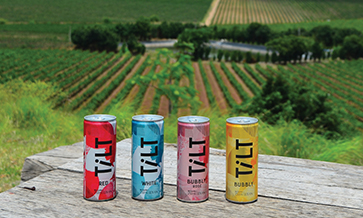The Bergerac-Dura region in South-West France, east of better-known Bordeaux, is home to vineyards that have no less than 17 appellations, and its range of wines comes in all five colours.
A touch of deliciousness, a zest of sport, a little culture and a lot of “Périgord Attitude”: This is what you will find as you weave your way through the Bergerac vineyards.
At the heart of the South-West quarter of France, east of Bordeaux, the ‘Bergerac-Duras’ wine area is located on both sides of the Dordogne River and spreads over the Lot-et-Garonne.
Without the Dordogne River, the Bergerac wine area would not be! This water route has been used since the 12th century, as merchants saw it as an opportunity for making business with England. The terraced vineyards slope up above its valley, and are divided into several areas.
On the right bank of the Dordogne, the terraces mostly consist of gravel, sand and alluvium. The left bank, which is the sunny side, presents a more dramatic landscape, with a succession of slopes where limestone or clay-limestone prevails.
Unique terroir
With identical landscapes and terroirs, an equal philosophy and shared values, the Bergerac and Duras wine areas are similar in many respects. Not to mention that the region is full of prestigious historical testimonies (castles, chartreuses, manors, bastides and abbeys) that lie in the middle of breathtaking landscapes.
Merlot and Cabernet Franc grow perfectly in these soils, producing elegant and powerful wines. An idyllic place where nature expresses itself freely, Bergerac-Duras boasts a convivial and relaxed way of life – a dream for inspired wine growers!
Duras’ sub-soils are on the prolongation of the Graves, the sub-soils of neighbouringBordeaux. They are composed of marine and fluvial sediments such as heavy and sticky clays called “Boulbènes” in the lower parts and the south of the vineyard; as well as marls and molasses and limestone and clay-limestone at a higher altitude.
White too
Although Duras is known for its reds, which constitute the majority of its production, it appears it also makes excellent white wines, and for good reason. Duras’ sub-soils of molasses and boulbènes are clearly suitable for the cultivation of white varieties.
The persistent cultivation of red grapes on a land that is clearly favourable to the development of white grapes is certainly due to the rebellious nature of its wine growers!
The region’s vineyards have no less than 17 appellations, and its range of wines comes in all five colours. To discover the story of the wines of Bergerac-Duras, from the birth of the vineyards during the Gallo-Roman times till today, a wine and tourism centre is expected to open in July 2019.
It is located in a 17th-century cloister with a 180° view on the River Dordogne and the old port of Bergerac. Here visitors will be able to experience wine tasting paired with Périgord gastronomy (foiegras, chestnut, walnut, farm poultry) while enjoying the terrace and the view on the river. They can also meet Bergerac Duras wine growers and prepare for tours in their vineyards.
Friendly Bergerac
The regional appellation, Bergerac Red, was recognised in 1936. It represents the entire territory of Bergeracois. Côtes de Bergerac got the AOC (Appellation d’OrigineContrôlée) in 1955.
There are more than 800 producers looking after 7,350 hectares of vineyards and producing an average of 380,000 hectolitres of wine from Bergerac red and rosé, Côtes de Bergerac red, Merlot, Cabernet Franc, Cabernet Sauvignon, Malbec, Bergerac white, Côtes de Bergerac white, Sauvignon white and grey, Sémillon and Muscadelle grapes.
While the Bergerac red is fruity, the Bergerac rosé is flowery, and the Bergerac dry white is expressive. Côtes de Bergerac red is determined to be intense, while the Côtes de Bergerac soft white is smooth.
Sweet Monbazillac
Worthy heirs of an ancestral expertise, they took up the modernity challenge with amazing sweet wines which can be drunk with any plate. These are efficient classical wines for aperitif with a few foiegras toasts, accompanied by a festive poultry, or surprising with veined cheese like Roquefort.
The Monbazillac appellation was recognised in 1936. More than 100 wine growers tend to 2,300 hectares of vineyards to produce 57,000 hectolitres of sweet wines per year from Sauvignon white and grey, Sémillon and Muscadelle grapes.
Gentle Pecharmant
At the gates of Bergerac, at the heart of the former North Vinee, châteaux and lovely mansions are all around the vineyard, which is full of natural biodiversity: woods, orchards, meadows with their elegant mounts.
Charming and whimsical, the real gentlemen farmers and wine makers contribute to make this place an unforgettable one, thanks to the wines produced there: the chopped reds of Pécharmant.
The Pécharmant appellation was recognised in 1946. More than 50 vineyard owners produce 14,000 hectolitres from Merlot, Cabernet Franc, Malbec and Cabernet Sauvignon grapes from 405 hectares of vineyards.
Duras’ rebels
To be a rebel is to resist. At least you have to be one if you want to practice as a real brave wine maker! The whole story of Duras wines is full of strong personalities, like Vicomte de Bezaume, who built the emblematic Chateau of Duras. But the rebellious behaviour of these wine makers is equal to their generosity, just like their wines full of personality.
Here, 200 vineyard owners cultivate Côtes de Duras red and rosé, Merlot, Cabernet Franc, Cabernet Sauvignon, Malbec, Côtes de Duras white, Sauvignon white and grey, Sémillon, Muscadelle, Mauzac, Ondenc, Chenin white and Ugni white.
The regional appellation, Côtes de Duras, was recognised in 1937. Over 1,200 hectares of vineyards contribute to the average annual production of 73,700 hectolitres of fruity and flowery wines.
Montravel’s soul
If wine is not vital to human alimentation, it seems essential as nourishment for their spirit and contributes certainly to the nobleness of their soul! Declined in four colours(dry white, soft, sweet and red) the Montravel wines have three appellations: Montravel, Côtes de Montravel and Haut-Montravel.
The regional appellation was recognised in 1937 for white wine and in 2001 for red wine.
About 150 hectares of vineyards yield 7,900 hectolitres of wines per year from Montravel red, Merlot, Cabernet Franc, Cabernet Sauvignon, Malbec, Montravel dry white, Côtes de Montravel, Haut-Montravel, Sauvignon white and grey, Sémillon and Muscadelle grapes.
Organic Saussignac
In order to be happy, we have to preserve our haven of peace and nature! This could be the motto of the wine makers of Saussignac, because most of them work organically. They create racy and airy sweet wines to accompany perfectly any festive meal.
They even have eco-friendly lodges in the heart of the vineyards – truly wine makers with a heart of gold!
The regional appellation Saussignac was recognised in 2005 to the average 500 hectolitres of wines produced annually from Sauvignon white and grey, Sémillon and Muscadelle grapes.
Soft Rosette
Rosette represents the story of a rebirth. The regional appellation was recognised in 1946. At the beginning of the year 2000, there were only four hardliners who were still producing Rosette wines. The appellation was about to die!
Fortunately, adventurers, wine makers and initiators newly installed in the region, made a crazy bet to re-launch Rosette production.
Sauvignon white and grey, Sémillon and Muscadelle grapes are cultivated over 44 hectares to produce 900 hectolitres per year.
– This article comes with courtesy of Interprofessional, the council of the Bergerac wine-growing region (www.vins-bergeracduras.fr/en/).














